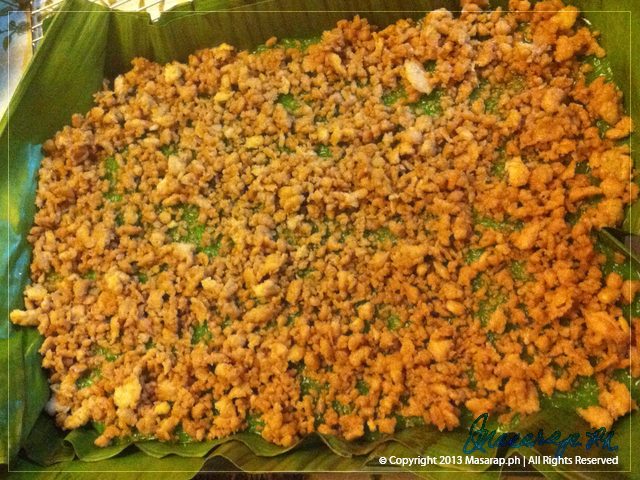 Duman is the gold edition of malagkit rice (sticky rice). The best duman is grown in Santa Rita, Pampanga. Planted during the rainy season, it waits for the cold weather of November and December before it is harvested. Duman is actually immature sticky rice. The rice is harvested while is it still immature and green. It is hand harvested; hand roasted; hand pounded; hand sifted, and therefore costs a mint! The cost of one ‘pati’ (about 3 kilos) of this young rice is equivalent to a fifty kilo sack of ordinary rice. Whoever thought of this process must have been a real gourmand and a glutton for work. One can eat the duman, raw, just as it is. The usual way one eats duman with is steaming hot chocolate. In a cup of hot chocolate, one sprinkles about 1/2 cup of the duman into the chocolate and then slowly spoons it into the salivating mouth. The other method of eating duman is to get newly harvest palm (sasa) juice that has been warmed and the duman sprinkled on it too. The reason that duman is so expensive is that only a few know how to do this and that they can only harvest it in its prime, which is only a few weeks. There is also available the ‘over the period’ kind but it’s already the stage when the rice begins to harden and cannot be eaten raw. There is also the fake kind, people color the ‘pinipig’ (as it’s also known) green. The true color of duman is a pale yellow green. So once a year, we were able to taste this precious sticky rice. There were times when I had more than I could eat and that is when I started to experiment with this. I know very well that you will not be able to do this; the basic ingredient is prohibitive and only comes out once a year for a few weeks. But then I wanted Filipinos to know that such a dish exists and it can only be found in the Philippines.
Duman is the gold edition of malagkit rice (sticky rice). The best duman is grown in Santa Rita, Pampanga. Planted during the rainy season, it waits for the cold weather of November and December before it is harvested. Duman is actually immature sticky rice. The rice is harvested while is it still immature and green. It is hand harvested; hand roasted; hand pounded; hand sifted, and therefore costs a mint! The cost of one ‘pati’ (about 3 kilos) of this young rice is equivalent to a fifty kilo sack of ordinary rice. Whoever thought of this process must have been a real gourmand and a glutton for work. One can eat the duman, raw, just as it is. The usual way one eats duman with is steaming hot chocolate. In a cup of hot chocolate, one sprinkles about 1/2 cup of the duman into the chocolate and then slowly spoons it into the salivating mouth. The other method of eating duman is to get newly harvest palm (sasa) juice that has been warmed and the duman sprinkled on it too. The reason that duman is so expensive is that only a few know how to do this and that they can only harvest it in its prime, which is only a few weeks. There is also available the ‘over the period’ kind but it’s already the stage when the rice begins to harden and cannot be eaten raw. There is also the fake kind, people color the ‘pinipig’ (as it’s also known) green. The true color of duman is a pale yellow green. So once a year, we were able to taste this precious sticky rice. There were times when I had more than I could eat and that is when I started to experiment with this. I know very well that you will not be able to do this; the basic ingredient is prohibitive and only comes out once a year for a few weeks. But then I wanted Filipinos to know that such a dish exists and it can only be found in the Philippines.
During my catering days, I would serve this and got requests to serve it again and had to turn them down because of it’s unavailability. I would just say, try again next year. It is very easy to make but hard to find. There is a saving grace in all this, one can freeze the duman even for a year. Wrap the duman in wilted banana leaves; then wrap with foil; wrap with Manila paper; then place in a resealable plastic bag; then freeze. The secret is keeping the duman moisture free. If you want to eat it raw, take the amount you want and leave at room temperature and then eat it.
Ingredients:
- 3 cups first class pinipig (duman)
- 1 cup thin coconut milk – thinned coconut milk from the second squeeze
- 2 cups thick coconut milk – milk from the first squeeze of the grated coconut
Note: you need 3 grated coconuts to make the milk - 1 cup sugar
How to Make thinned Coconut Milk:
- In a large bowl, place the three grated coconuts and add 2 cups of cold water.
- Mash the grated coconut with hands and then squeeze into another bowl the coconut milk.
- Then strain with muslin (katcha) cloth and set aside.
- Pour 2 cups of cold water into the grated coconut and squeeze again; and strain; this is the thinned coconut milk.
Procedure:
- Soak the duman in thin coconut milk for 1/2 hour.
- Boil the thick coconut milk with sugar, over medium fire, in a wok, until the sugar is syrupy.
- Add the duman with the thin coconut milk.
- Turn down the fire to low.
- Keep stirring the mixture, making sure it does not stick to the bottom of wok.
- When the mixture starts to detach itself from the wok, pour the mixture into a serving dish lined with wilted banana leaf. The cooking time is short; about 10 to 15 minutes.
- Top with Latik.
Latik Procedure:
Latik is pure coconut milk that has been reduced till the oil (from the coconut) and the coconut cream separate.
You need 2 cups of thick coconut milk.
- Place the coconut milk in a small wok or non stick frying pan.
- Place the pan over low fire and bring to a slow boil.
- Do not stir the pan.
- Let the coconut cream coagulate and just occasionally stir to prevent the cream from sticking to the bottom.
- You need the cream to coagulate into tiny pebble-like masses.
- When the coagulated cream looks like a light tan, then with a strainer, pour out the oil and and place the clotted coconut cream in a serving bowl and leave some of the oil with it.
- This takes about 30 minutes or so.
- Use the clotted coconut cream as a topping on the Kalamay na Duman.

I made this today with leftover duman (which was stored in the freezer). It was so good! I tweaked the recipe a bit by adding 2 pandan leaves (split lengthwise and tied into a knot). I added it while cooking the coconut milk with sugar and removed it only when the duman was ready to be transferred to the serving dish.
That’s a great tweak! Glad you enjoyed the recipe.
San nakakabili ng glutinous rice na pinipig?
Nakakabili kami sa palengke.
can i use duman instead of ordinay rice to make burung hito?
It’s a rather expensive ingredient replacement that adds no additional taste. The best is still your favorite white rice.
I know it’s late in the season but where can I get some duman right now? Anyone have some stored in the freezer ????